Let’s begin the New Year with the charming art of Constantin Alajálov.
Giant Clock on New Year’s Eve — January 1, 1949
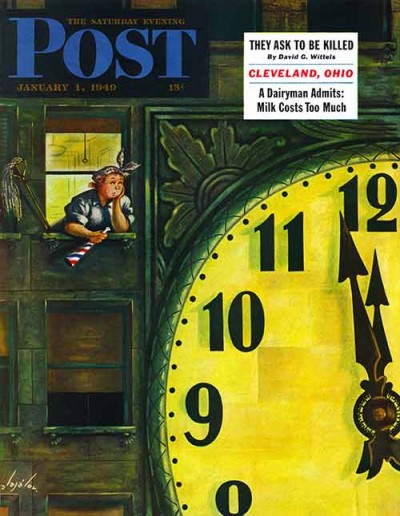
Giant Clock on New Year’s Eve
From January 1, 1949
Not everyone has a fancy party to attend on New Year’s Eve. Some of us have to work, like this less-than-enthused office cleaner. The artist was visiting Gardone, Italy when he found a local to model as his scrubwoman and “invented a skyscraper to go around her neck,” according to Post editors.
Constantin Alajálov was born in 1900 to well-off Russian parents. They were able to give him the advantage of schooling, but his professional training did not last long; he had barely started at the University of Petrograd when the Russian Revolution broke out. He traveled around the country with a group of artists, painting posters and murals of Communist propaganda in order to survive.
No Desserts — March 12, 1949
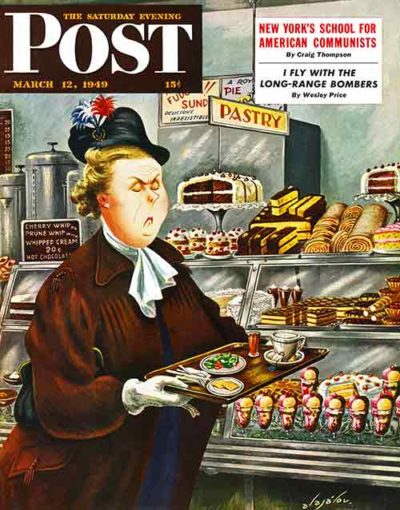
No Desserts
From March 12, 1949
Ah, so begins the New Year for many of us. It would not do to spoof a “stout” lady these days, but it worked in 1949.
Alajálov became the court painter for a khan in Persia. The khan was hanged by his successor, so there went that position. He moved on to Constantinople and painted murals and posters before landing in New York in 1923. Within three years, he sold his first cover to The New Yorker.
Sunday Paper — February 21, 1948
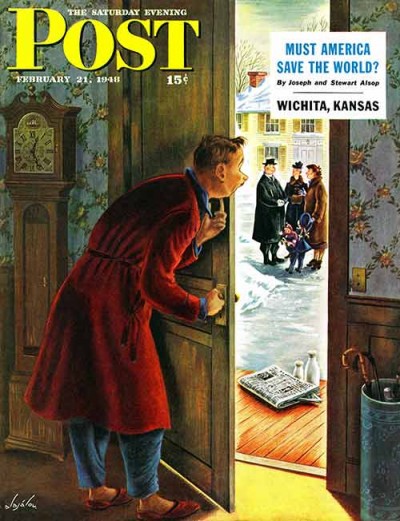
This late-sleeping Sunday slacker is one of my favorite Alajálov covers. The poor sinner really wants that Sunday paper and the milk for his coffee, but who is having a confab outside his door? None other than the minister, of course.
Alajálov eventually became the only person to do covers for both The New Yorker and The Saturday Evening Post, despite the fact that both magazines required exclusivity in their cover artists. He was naturalized in the United States and spent the rest of his life traveling and painting in and out of the country.
Fall Gab Session — November 7, 1953
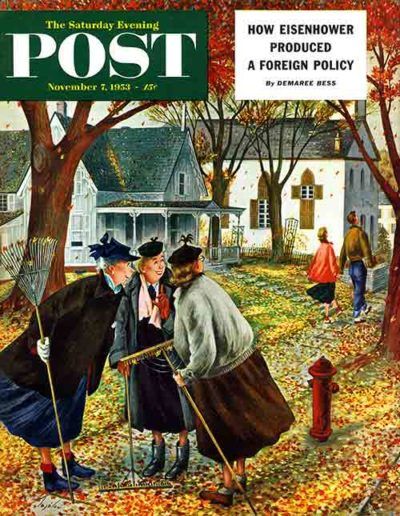
This wonderful autumn cover from 1953 shows a gossip session in full force. It looks like the Smith boy is seeing the Jones girl and the ladies of the town will only be too happy to spread the rumor that they are in love—confidentially, of course.
Trying on the Old Uniform — May 31, 1958
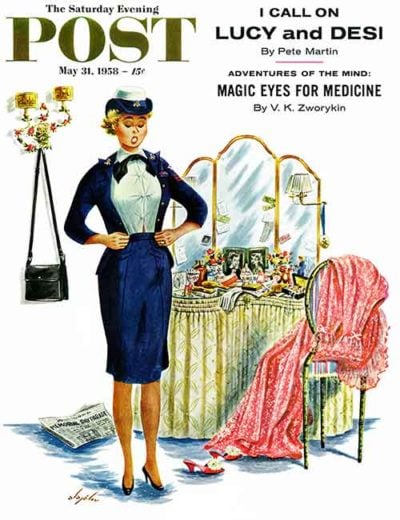
What a difference 10 or 15 years makes! It is now 1958, and slipping into her old WWII WAVE uniform for a Memorial Day parade is not as easy as the charming young matron thought. (WAVES was an acronym for Women Accepted for Volunteer Emergency Service, began in 1942. It was technically US Naval Reserves, but the term “WAVES” caught on.) What did the 1958 crop of WAVES think of Post cover? They loved it! The WAVES director asked for the painting to be hung permanently in Washington and a WAVE at the Anacostia Naval Air Station asked for 50 autographed reprints for her crew. The artist happily granted both requests.
Photo of Constantin Alajálov — October 6, 1945
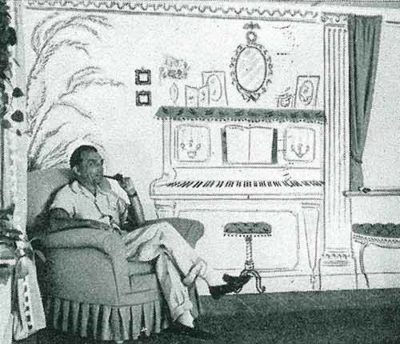
Photo of Constantin Alajálov
From October 6, 1945
The October 6, 1945, issue of the Post not only boasted Alajálov’s first cover for that magazine, but a playful photo in the “Keeping Posted” column. The artist is sitting in his comfy chair next to a charming piano. The piano, however, as with most of the room’s “furnishings,” is not real. “If a room seems to need a door,” Post editors noted, “Alajálov paints himself a door. If it needs a window and a view, he paints both window and view, and can thereby look out on anything he wants.”
Of course, the room has limitations as well as advantages. “Guests cannot sit down and stay,” editors noted, “which is a good thing, and Alajálov has furniture of any period…he fancies. He can have the throne Catherine of Russia sat in, if he likes—in fact, he can have Catherine of Russia, gazing at him in admiration and ardor.”
Bridge Hand Disturbs Sleep — December 1, 1962
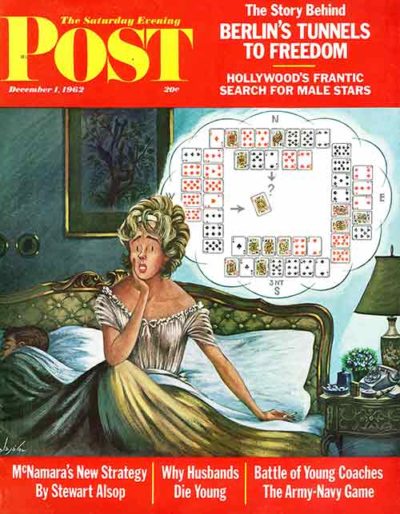
At the age of sixty-two, a retiring Alajálov submitted his final Saturday Evening Post cover. The December 1, 1962, issue depicted a bridge player distressed over a game where she should have bid this or played that or should not have withheld the ace of diamonds.
Roger T. Reed of Illustration House once said of Alajálov, “When I met him in 1984, the artist was a refined and patrician figure, with reason to be proud of a rich body of work in fine illustrative art.” The artist passed away in New York at the age of 87.
Become a Saturday Evening Post member and enjoy unlimited access. Subscribe now
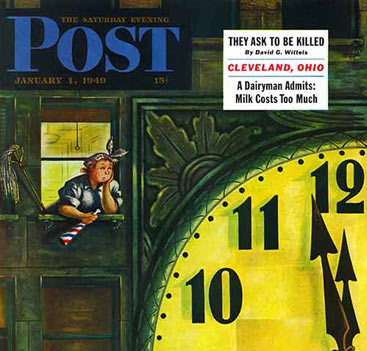

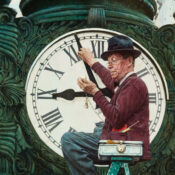
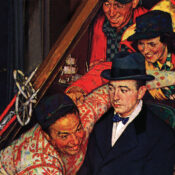
Comments
Hello, I am so happy to find this article as I thought my original Constantin Alajolav cover was by Peter Arno. I own the original of the last cover your magazine used of his work in 1962. The woman in bed (the bridge player). It has been hanging in my butler’s pantry for the last 16 years. Does it have a value, please. With best regards
Thank you for highlighting cover artist Alajalov. Excellent covers. I thought they were all excellent. I especially liked the “Sunday Paper”. His work is almost as realistic as Rockwell, except for the faces. They may be catoonish (as mentioned by Mr. McGowan) but fit the covers perfectly.He must have had a great sense of humor.
As a vintage POST cover lover, I have a particular fondness for Constantin Alajalov’s post-World War ll covers. I LOVE your insights (as usual), and have to give you the prize this week for the May 31, 1958 cover.
As a guy who loves his ‘Covers of the Saturday Evening Post’ book, it’s amazing how often I’ll see a cover (like the 5/31/58) that I’ve never seen before! I don’t know know that happens. My birthday is 5/26, so this was my “first birthday” issue.
As far as my OWN insights go, it’s interesting how realistic his background art was, with the people’s faces often being the main “cartoonish” aspect. I’m so pleased the cover was honored the way it was. It certainly deserved it.